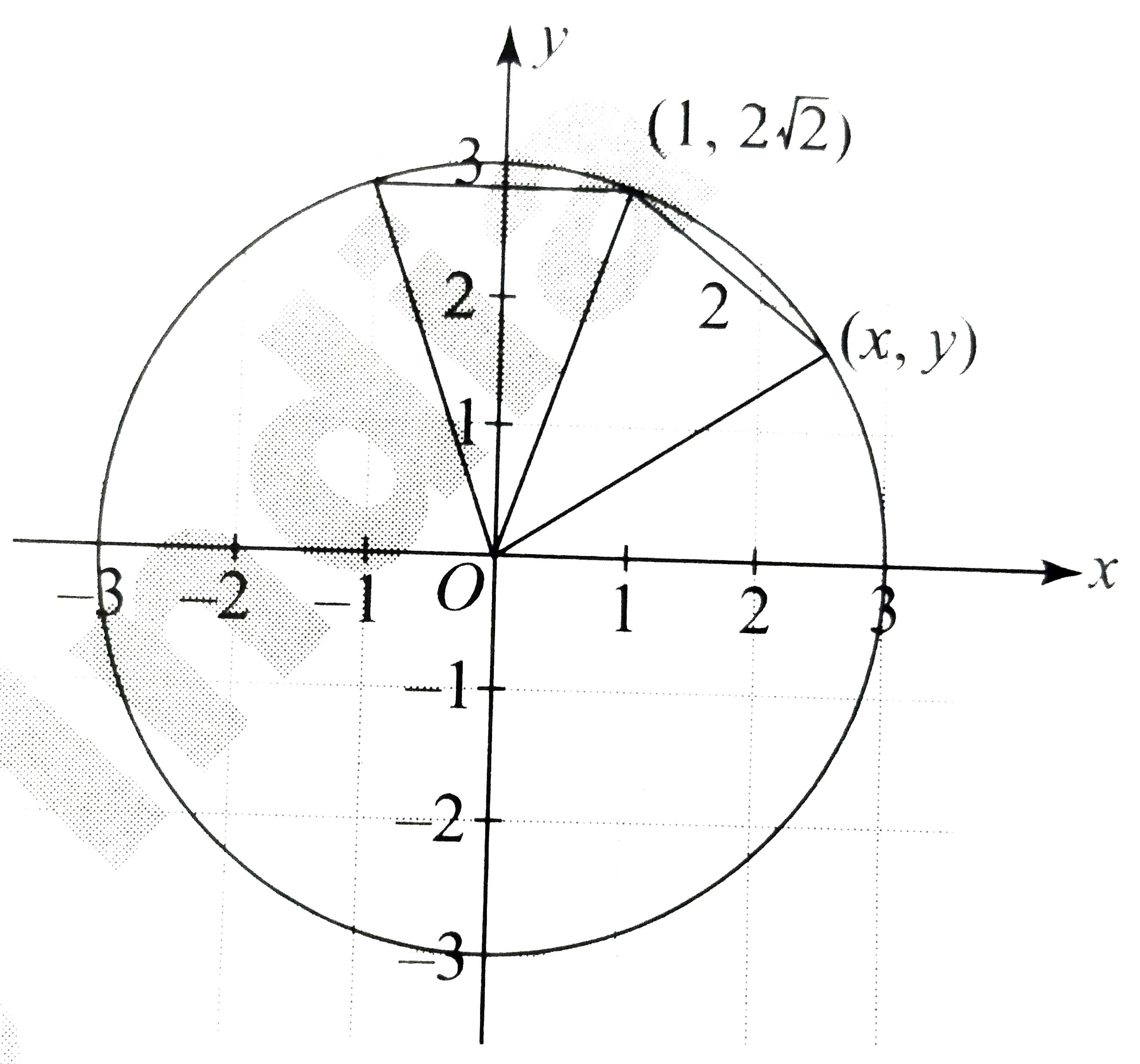A(1√2,1√2) is a point on the circle x2+y2=1 and B is another point on the circle such that arc length AB=π2 units. Then, the coordinates of B can be (a) (1√2,−1√2) (b) (−1√2,1√2) (c) (−1√2,−1√2) (d) none of theseSolution in Bengali
(−1,2√2)
(2√2,1)
(239,10√29)
None of these
The correct Answer is:B

x1−1cosθ=y1−2√2sinθ=2 (using parametric form of straight line)
Also, x21+y21=9
On solving, we get
(1+2cosθ)2+(2√2+2sinθ)2=9
cosθ=79 or −1
Then the required point is (−1,2√2),(239,10√29)
Topper's Solved these Questions
- CIRCLESBOOK - CENGAGE PUBLICATIONCHAPTER - CIRCLESEXERCISE - Multiple Correct Answers Type
9 Videos
- CIRCLESBOOK - CENGAGE PUBLICATIONCHAPTER - CIRCLESEXERCISE - Comprehension Type
8 Videos
- CIRCLE BOOK - CENGAGE PUBLICATIONCHAPTER - CIRCLE EXERCISE - For problems 3 and 4
2 Videos
- COMPLEX NUMBERSBOOK - CENGAGE PUBLICATIONCHAPTER - COMPLEX NUMBERSEXERCISE - MULTIPLE CORRECT ANSWER TYPE
6 Videos
Similar Questions
The line 3x+6y=k intersects the curve 2x2+3y2=1 at points AandB . The circle on AB as diameter passes through the origin. Then the value of k2 is__________
View Solution
In the diagram as shown, a circle is drawn with centre C(1,1) and radius 1 and a line L. The line L is tangent to the circle at Q. Further L meets the y-axis at R and the x-axis at P in such a way that the angle OPQ equals θ where 0<θ<π2.
Coordinate of Q is
View SolutionPARAGRAPH X Let S be the circle in the xy -plane defined by the equation x2+y2=4. (For Ques. No 15 and 16) Let E1E2 and F1F2 be the chords of S passing through the point P0(1, 1) and parallel to the x-axis and the y-axis, respectively. Let G1G2 be the chord of S passing through P0 and having slope −1 . Let the tangents to S at E1 and E2 meet at E3 , the tangents to S at F1 and F2 meet at F3 , and the tangents to S at G1 and G2 meet at G3 . Then, the points E3, F3 and G3 lie on the curve x+y=4 (b) (x−4)2+(y−4)2=16 (c) (x−4)(y−4)=4 (d) xy=4
View SolutionLet z1 and z2 be two distinct complex numbers and z=(1−t)z1+tz2, for some real number t with 0<t<1 and i=√−1. If arg(w) denotes the principal argument of a non-zero compolex number w, then
View SolutionA(1√2,1√2) is a point on the circle x2+y2=1 and B is another point on the circle such that are length AB=π2 units. Then, the coordinates of B can be (1√2,1√2) (b) (−1√2,1√2) (−1√2,−1√2) (d) none of these
View SolutionA circle S of radius 'a' is the director circle of another circle S1,S1 is the director circle of circle S2 and so on. If the sum of the radii of all these circle is 2, then the value of 'a' is 2+√2 (b) 2−1√2 2−√2 (d) 2+1√2
View SolutionIf a=(sqrt(2)+1)/(sqrt(2)-1),b=(sqrt(2)-1)/(sqrt(2)+1), prove that a^(2)+ab+b^(2)=35
View Solutionlimx→1−√π−√2sin−1x√1−x= (A) √2π (B) √π2 (C) 1π (D) √1π
View SolutionSolution of (2+sqrt(3))^(x^(2)-2x+1)+(2-sqrt(3))^(x^(2)-2x-1)=(4)/(2-sqrt(3))are(A)1+-sqrt(3),1(B)1+-sqrt(2),1(C)1+-sqrt(3),2(D)1+-sqrt(2),2
View SolutionThe image of the centre of the circle x2+y2=2a2 with respect to the line x+y=1 is : (A) (√2,√2 (B) (1√2,√2) (C) (√2,1√2) (D) none of these
View SolutionTangents drawn from (2,0) to the circle x2+y2=1 touch the circle at AandB. Then (A) A≡(12,√32), B -= (-1/2, - sqrt(3)/2)(B)A-= (- 1/2, (-sqrt(3)/2),B≡(12,√32) (C) A≡(12,√32), B-= (1/2, - sqrt(3)/2) (D) A≡(12,−√32),B≡(12,√32)
View SolutionA(1√2,1√2) is a point on the circle x2+y2=1andB is another point on the circle such that AB=π2 units. Then coordinates of B can be : (A) (1√2,−1√2) (B) (−1√2,1√2) (C) (−1√2,−1√2) (D) none of these
View SolutionIf a=(sqrt(2)+1)/(sqrt(2)-1) and b=(sqrt(2)-1)/(sqrt(2)+1) ,then find the value of a^(2)+b^(2)-4ab
View Solutionयदि a=√2+1√2−1,b=√2−1√2+1 सिद्ध करें कि a2+ab+b2=35.
View SolutionThe value of (lim)x→1√2(x−cos(sin−1x)1−tan(sin−1x)) is (a) −1√2 (b) 1√2 (c) √2 (d) −√2
View SolutionA(1√2,1√2) is a point on the circle x2+y2=1 and B is another point on the circle such that are length AB=π2 units. Then, the coordinates of B can be (a) (1√2,−1√2) (b) (−1√2,1√2) (c) (−1√2,−1√2) (d) none of these
View Solution
